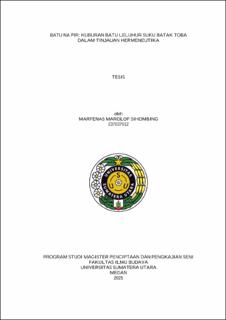Batu na Pir: Kuburan Batu Leluhur Suku Batak Toba dalam Tinjauan Hermeneutika
Batu na Pir: Stone Grave of the Ancestors of the Batak Toba Tribe in Hermeneutic Review

Date
2025Author
Sihombing, Marfenas Marolop
Advisor(s)
Nasution, Ikhwanuddin
Metadata
Show full item recordAbstract
This research, titled “Batu Na Pir: Stone Grave of The Ancestors of The Batak Toba Tribe In Hermeneutic Review”, aims to interpret the symbolic meaning, aesthetic value, and cultural function of Batu na Pir as a traditional art form deeply rooted in Batak Toba spirituality and social structure. These stone tombs serve not only as final resting places for ancestors but also as symbolic media connecting the living with nature and the spirit world. Using a qualitative case study approach, data were collected through observation, in-depth interviews, and field documentation. The study is guided by Hans-Georg Gadamer’s hermeneutics, Clifford Geertz’s symbolism theory, and traditional art theory.Findings reveal that Batu na Pir holds profound meaning as a symbol of social status, spirituality, and Batak Toba identity. Its interpretation is dynamic, adapting over timse. Symbols such as buffalo heads and gorga carvings reflect the integration of art, belief, and cultural values. The study also highlights the importance of preserving Batu na Pir as a source of cultural education.
